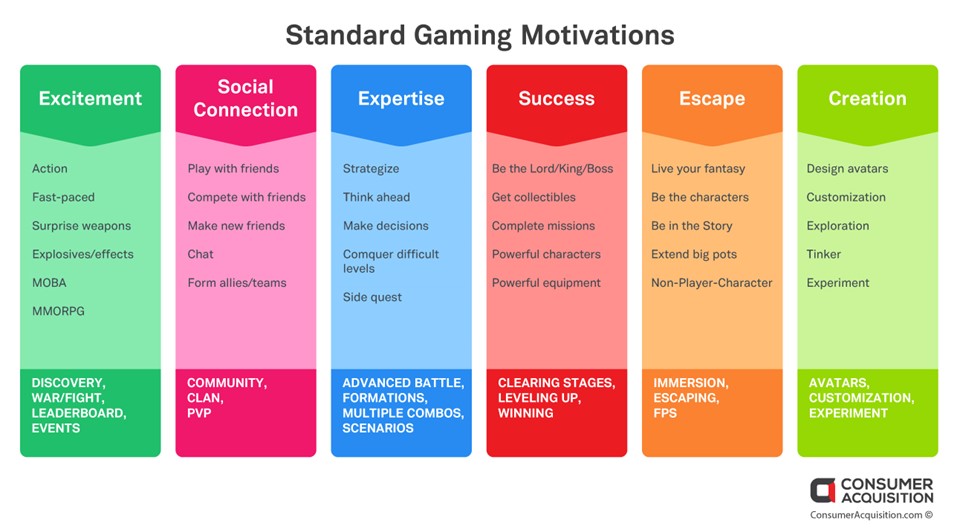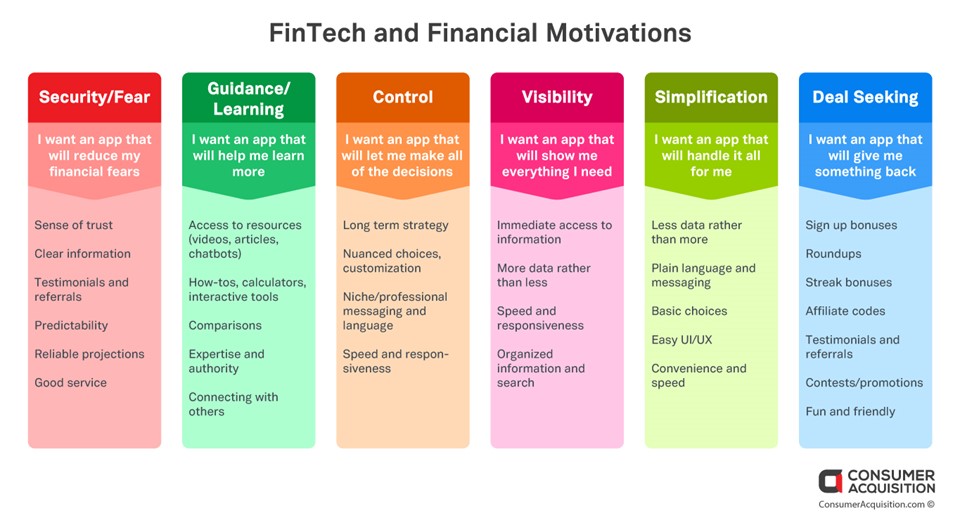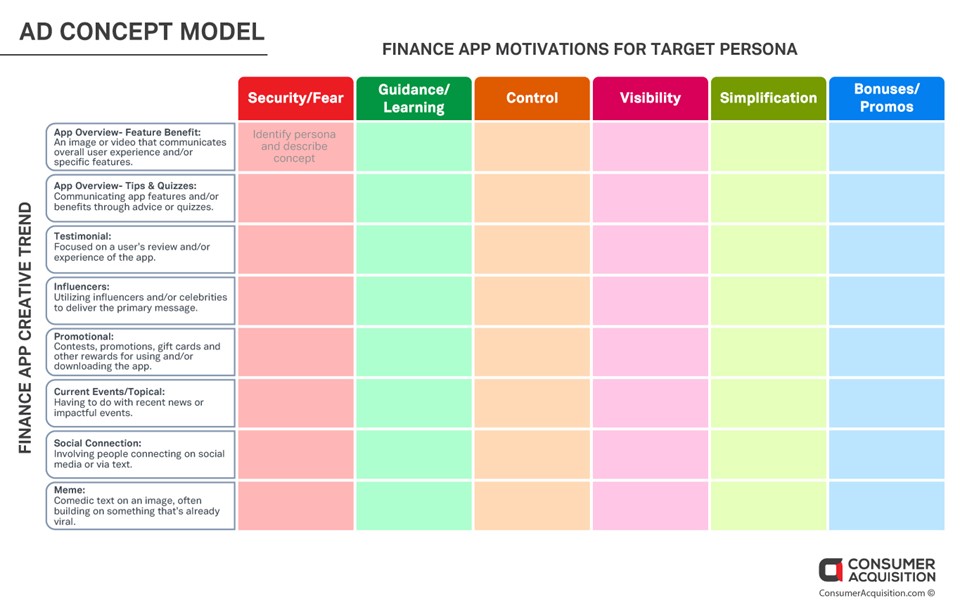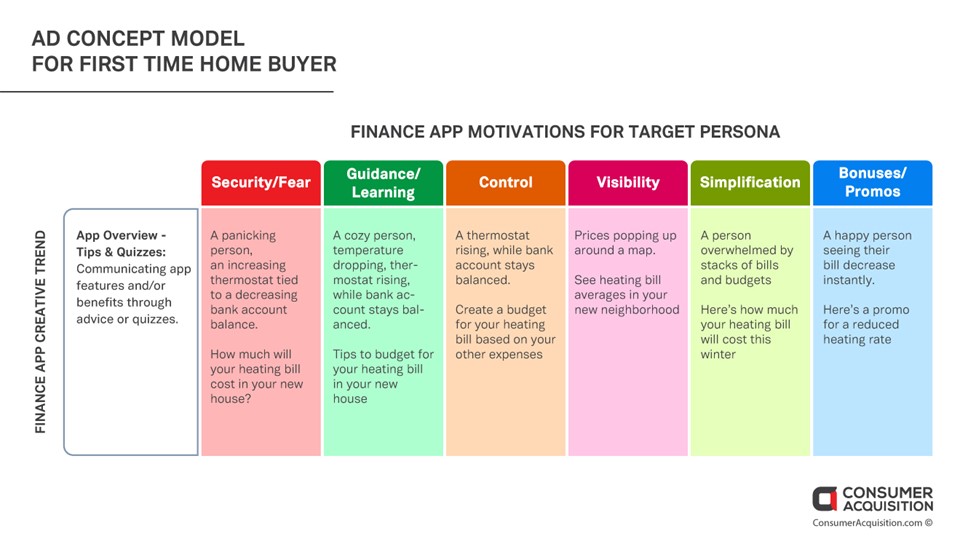Based on over 100,000 videos and images we produce and test yearly for our clients, our research has shown that winning ads last only 10 weeks, before they burn out. We have performed over 25,000 A/B and multivariate tests on Facebook, Google, TikTok and Snap, and have learned that 85-95% of new creative concepts fail to outperform your best ad. To survive in this volatile ad ecosystem, you’ll need 20-50 new concepts to find your next winning creative. And you’ll need to keep developing new concepts to stay ahead of creative fatigue.
By: Brian Bowman, ConsumerAcquisition.com
Tying persona-led ad creative to user motivation is what Facebook calls a “future-proof solution” for UA and creative teams. With the negative impacts of IDFA loss, including erosion of lookalike audience targeting and A/B testing, ad creative based on persona motivation is the most efficient lever for sustained profitable user acquisition.
The following Ad Concept Model is designed to systematize creative development and UA targeting based on iterative testing. These are the steps within the model:
- Identify creative trends within a category
- Identify motivations within a category
- Map creative trends to motivations within a category
- Create concepts for one persona at the intersection of each trend and motivation
- Repeat step 4 for all additional personas
Using these steps, we’ll show you how we create dozens of persona-led ad concepts efficiently and effectively with this Ad Concept Model. Every app category or game sub-genre can leverage a unique combination of distinct emotional triggers and creative trends to attract users.
CREATIVE TRENDS
Step 1: Identify creative trends within a category
Start with your internal data on what creative is working best already, then go deep on what’s working for competitors. Use Facebook Ad Library to see every ad currently running on their ad network. For implied success metrics, you can use Mobile Action, SensorTower, or AppAnnie competitor libraries. Your goal is to get a broad view of what creative is working and what isn’t across the category. Identify the creative trends you’re seeing and segment those trends.
Depending on the app category, some creative trends may include:
- An app overview focused on overall user experience and/or specific features
- An app overview using tips and quizzes
- Testimonials and reviews from users
- Influencers and celebrities delivering the primary message
- Social connection, social media, and chatting
- Achievement opportunities like level progression and mastery
- Vignettes featuring short character scenarios or stories
Competitive research will reveal which creative trends are working best across social platforms.
MOTIVATIONS
Step 2: Identify motivations within a category
As consumer marketing has grown up, we’ve learned there is no perfect Pepsi, but there are perfect Pepsis for particular palates; the same goes for products in any market. Before building out a matrix for a particular set of ad concepts, we identify different motivations driving our user personas and break down those motivations by underlying values and desires. Below we’ve included motivational triggers for fashion games as compared to fintech apps to show the distinction between categories. The triggers and preferences used for gamers are clearly different from financial users.


CREATIVE TRENDS X MOTIVATIONS
Step 3: Map creative trends to motivations within a category
Map identified motivations to creative trends within the category to develop and iterate on different concepts. In the empty model below, each box represents a different ad creative concept.
If you take an example like fashion games or fintech apps, the ad concept matrices each support nearly 50 concepts by pairing eight trends with six motivations.


CREATIVE TREND X MOTIVATION X PERSONA
Step 4: Create concepts for one persona at the intersection of each trend and motivation
While not all creative trends will work persuasively with each motivation, we can expand our concepts even further by targeting specific personas within each pairing. Based on personas, develop a bespoke creative strategy targeting behaviors, triggers, and preferences.
For example, concepts for a “first-time home buyer” as a persona can be extrapolated out to fill the entire matrix. Below, we’ve taken one fintech creative trend — Tips and Quizzes — and simplified some example concepts using six different motivations for a first-time home buyer persona.

REPEAT
Step 5: Repeat the previous step for all additional personas
Just as we’ve done for a first-time home buyer, you can build out concepts for other target personas as well. Consider someone who just started a new job, or hit a milestone birthday, or just received an inheritance. Messaging, imagery, pacing, and even tone will trigger different responses for different personas. Using an Ad Concept Model, these four personas (homebuyer, new job, milestone birthday, inheritance) provide an opportunity for almost two hundred concepts.
Why use a model like this?
We’ve learned why it can be hard to beat your control video. But, a constant stream of fresh creative concepts and smart, iterative testing means we can beat the algorithmic odds. Using an Ad Concept Model ensures you always have new creative concepts to stay ahead of creative fatigue. Using a systematized process helps you know what works, why it works, and how to do more of it. From niche to mainstream, creative concepting models mean you can get reliable top-performing creative in the most cost-efficient and scalable way.
Read Also: Q&A with Ogury: User-Driven Mobile Advertising and Fraud Prevention


